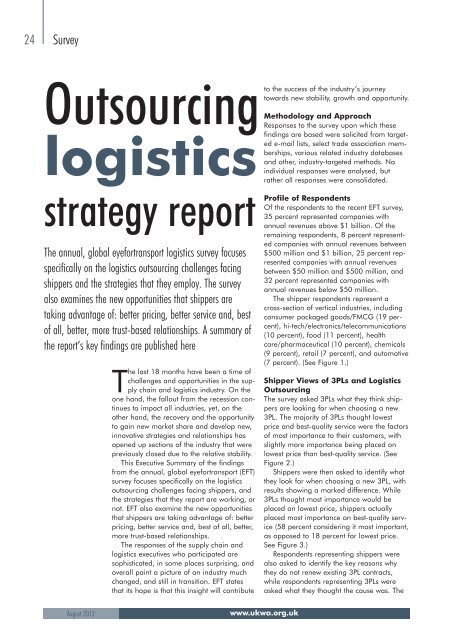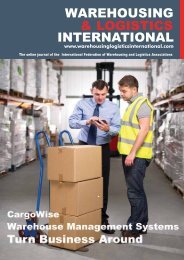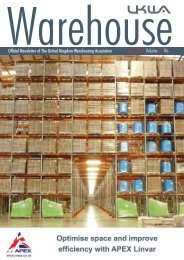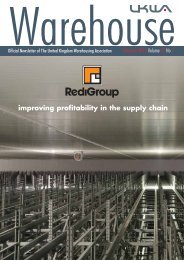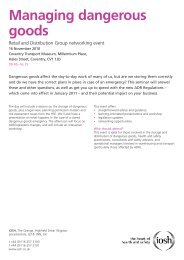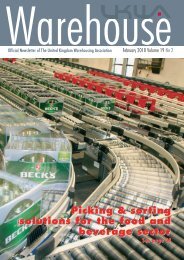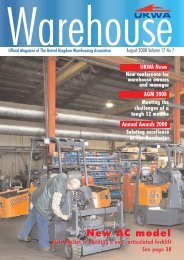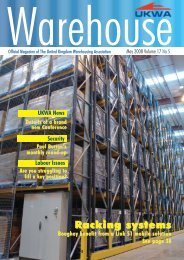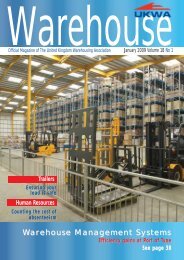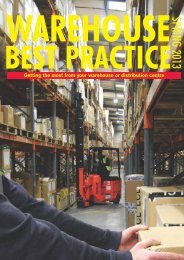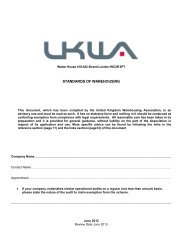Pictured - United Kingdom Warehousing Association
Pictured - United Kingdom Warehousing Association
Pictured - United Kingdom Warehousing Association
You also want an ePaper? Increase the reach of your titles
YUMPU automatically turns print PDFs into web optimized ePapers that Google loves.
24 SurveyOutsourcinglogisticsstrategy reportThe annual, global eyefortransport logistics survey focusesspecifically on the logistics outsourcing challenges facingshippers and the strategies that they employ. The surveyalso examines the new opportunities that shippers aretaking advantage of: better pricing, better service and, bestof all, better, more trust-based relationships. A summary ofthe report’s key findings are published hereThe last 18 months have been a time ofchallenges and opportunities in the supplychain and logistics industry. On theone hand, the fallout from the recession continuesto impact all industries, yet, on theother hand, the recovery and the opportunityto gain new market share and develop new,innovative strategies and relationships hasopened up sections of the industry that werepreviously closed due to the relative stability.This Executive Summary of the findingsfrom the annual, global eyefortransport (EFT)survey focuses specifically on the logisticsoutsourcing challenges facing shippers, andthe strategies that they report are working, ornot. EFT also examine the new opportunitiesthat shippers are taking advantage of: betterpricing, better service and, best of all, better,more trust-based relationships.The responses of the supply chain andlogistics executives who participated aresophisticated, in some places surprising, andoverall paint a picture of an industry muchchanged, and still in transition. EFT statesthat its hope is that this insight will contributeto the success of the industry’s journeytowards new stability, growth and opportunity.Methodology and ApproachResponses to the survey upon which thesefindings are based were solicited from targetede-mail lists, select trade association memberships,various related industry databasesand other, industry-targeted methods. Noindividual responses were analysed, butrather all responses were consolidated.Profile of RespondentsOf the respondents to the recent EFT survey,35 percent represented companies withannual revenues above $1 billion. Of theremaining respondents, 8 percent representedcompanies with annual revenues between$500 million and $1 billion, 25 percent representedcompanies with annual revenuesbetween $50 million and $500 million, and32 percent represented companies withannual revenues below $50 million.The shipper respondents represent across-section of vertical industries, includingconsumer packaged goods/FMCG (19 percent),hi-tech/electronics/telecommunications(10 percent), food (11 percent), healthcare/pharmaceutical (10 percent), chemicals(9 percent), retail (7 percent), and automotive(7 percent). (See Figure 1.)Shipper Views of 3PLs and LogisticsOutsourcingThe survey asked 3PLs what they think shippersare looking for when choosing a new3PL. The majority of 3PLs thought lowestprice and best-quality service were the factorsof most importance to their customers, withslightly more importance being placed onlowest price than best-quality service. (SeeFigure 2.)Shippers were then asked to identify whatthey look for when choosing a new 3PL, withresults showing a marked difference. While3PLs thought most importance would beplaced on lowest price, shippers actuallyplaced most importance on best-quality service(58 percent considering it most important,as opposed to 18 percent for lowest price.See Figure 3.)Respondents representing shippers werealso asked to identify the key reasons whythey do not renew existing 3PL contracts,while respondents representing 3PLs wereasked what they thought the cause was. TheAugust 2012www.ukwa.org.uk


